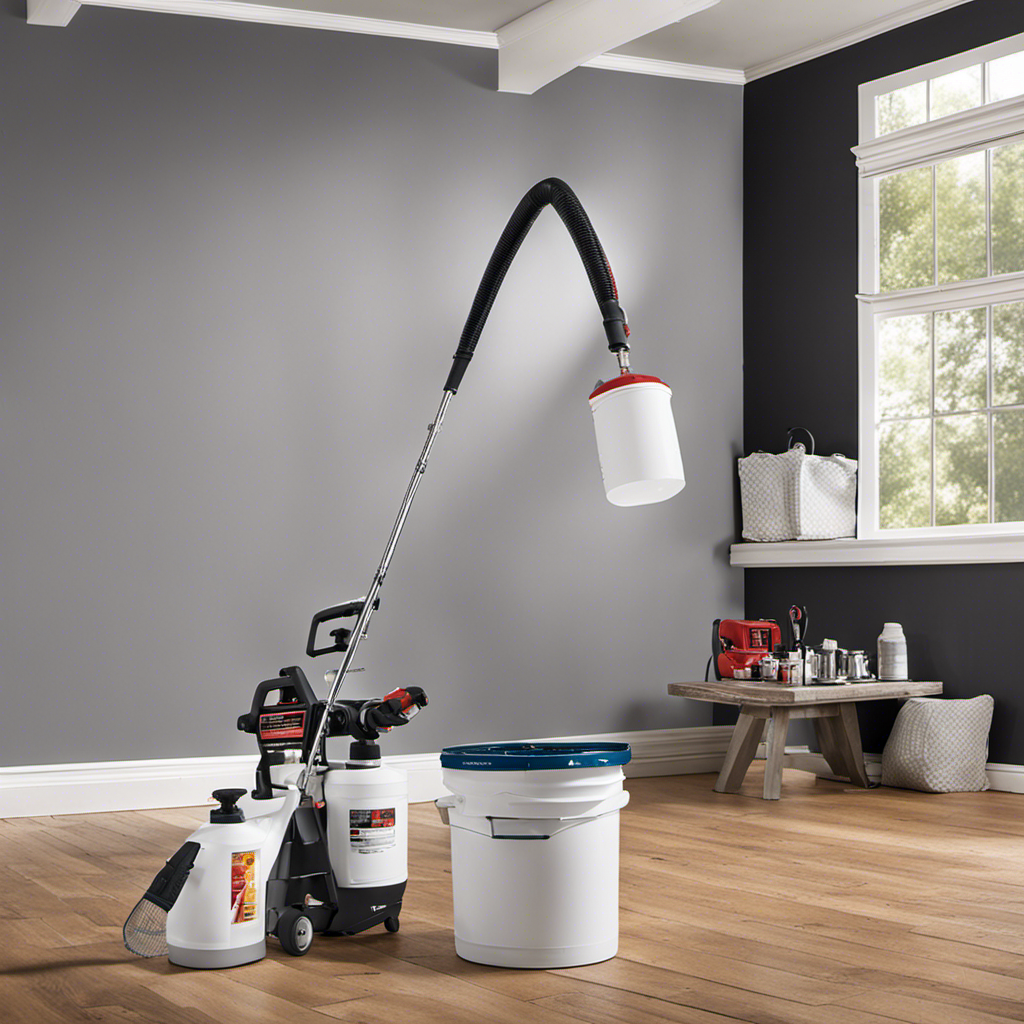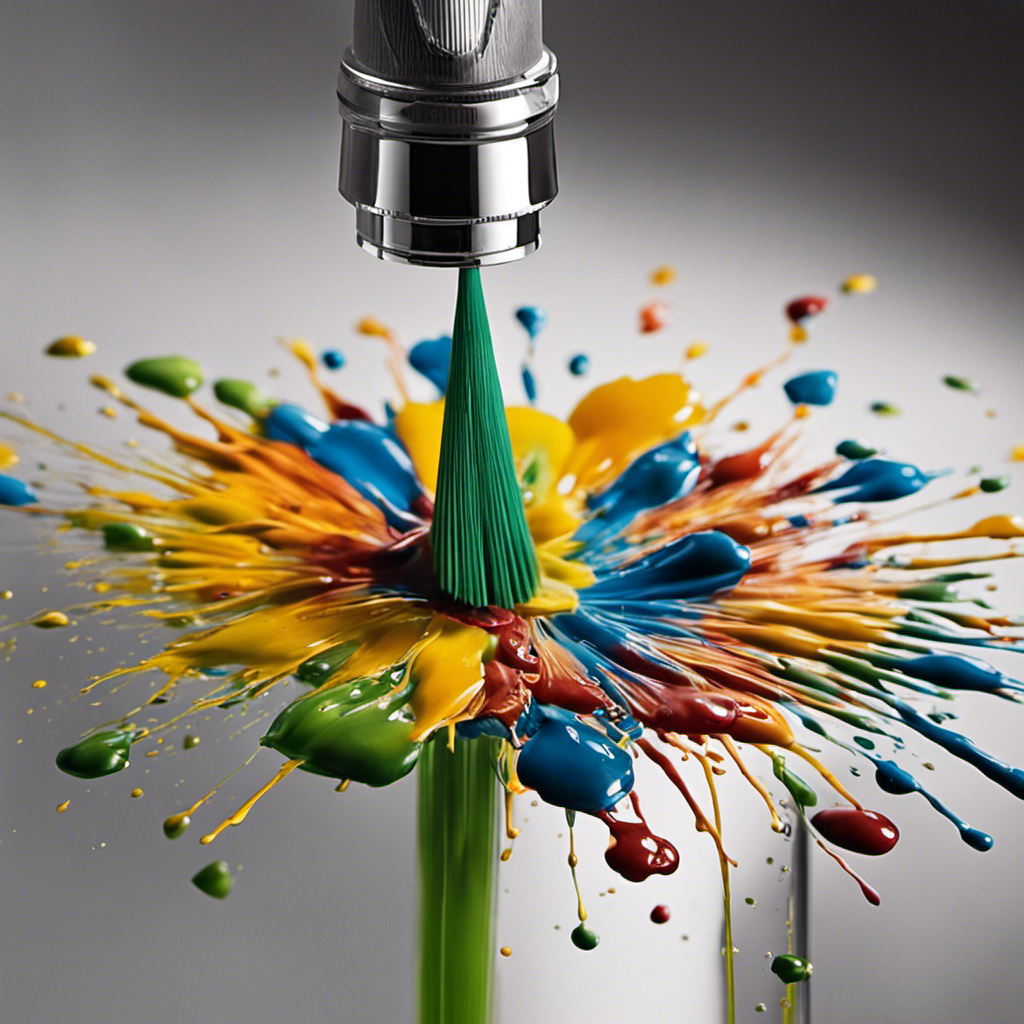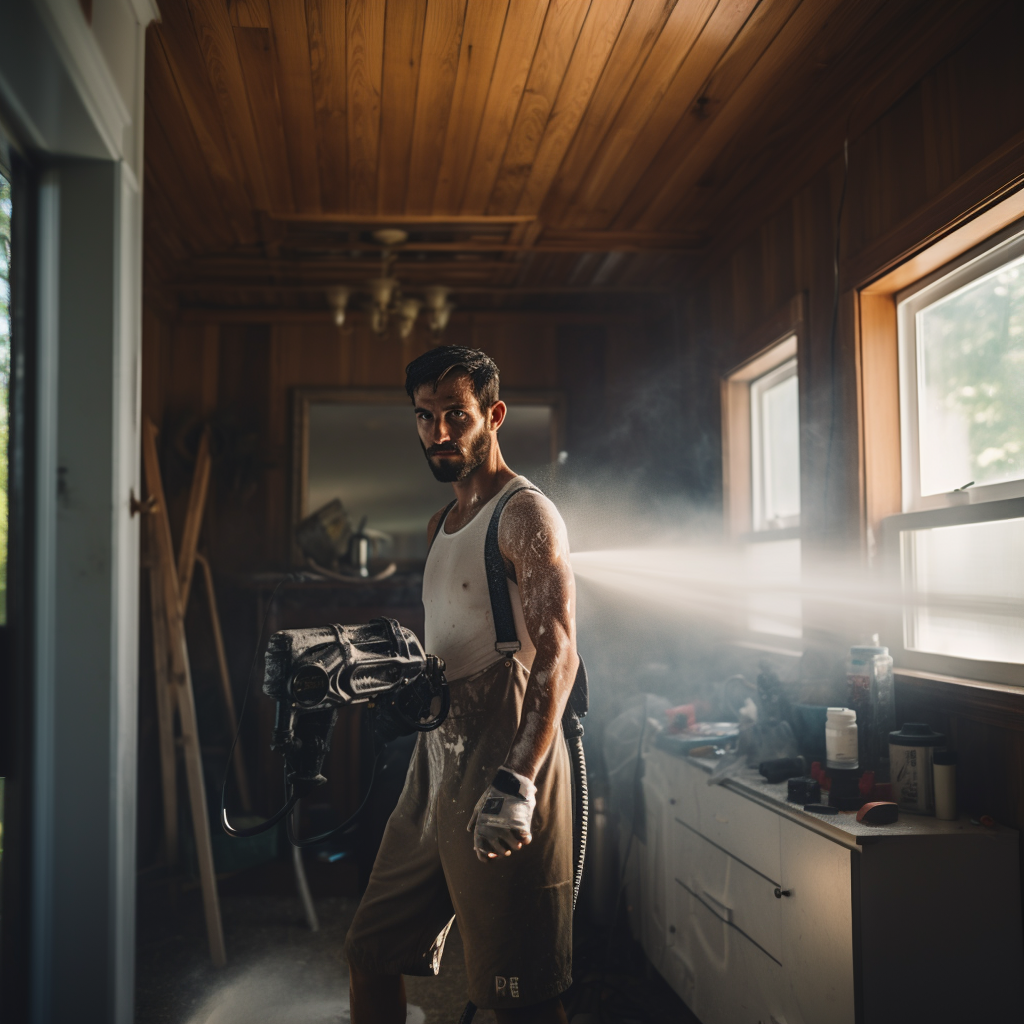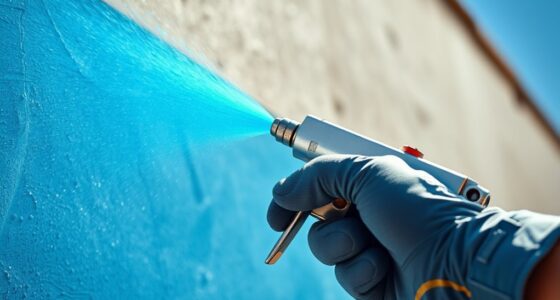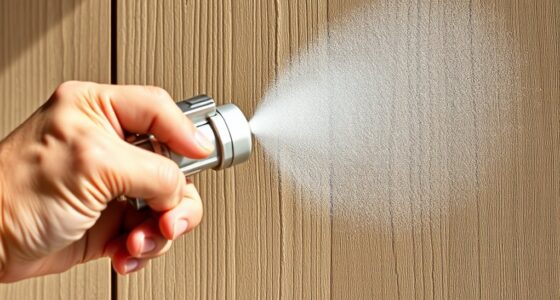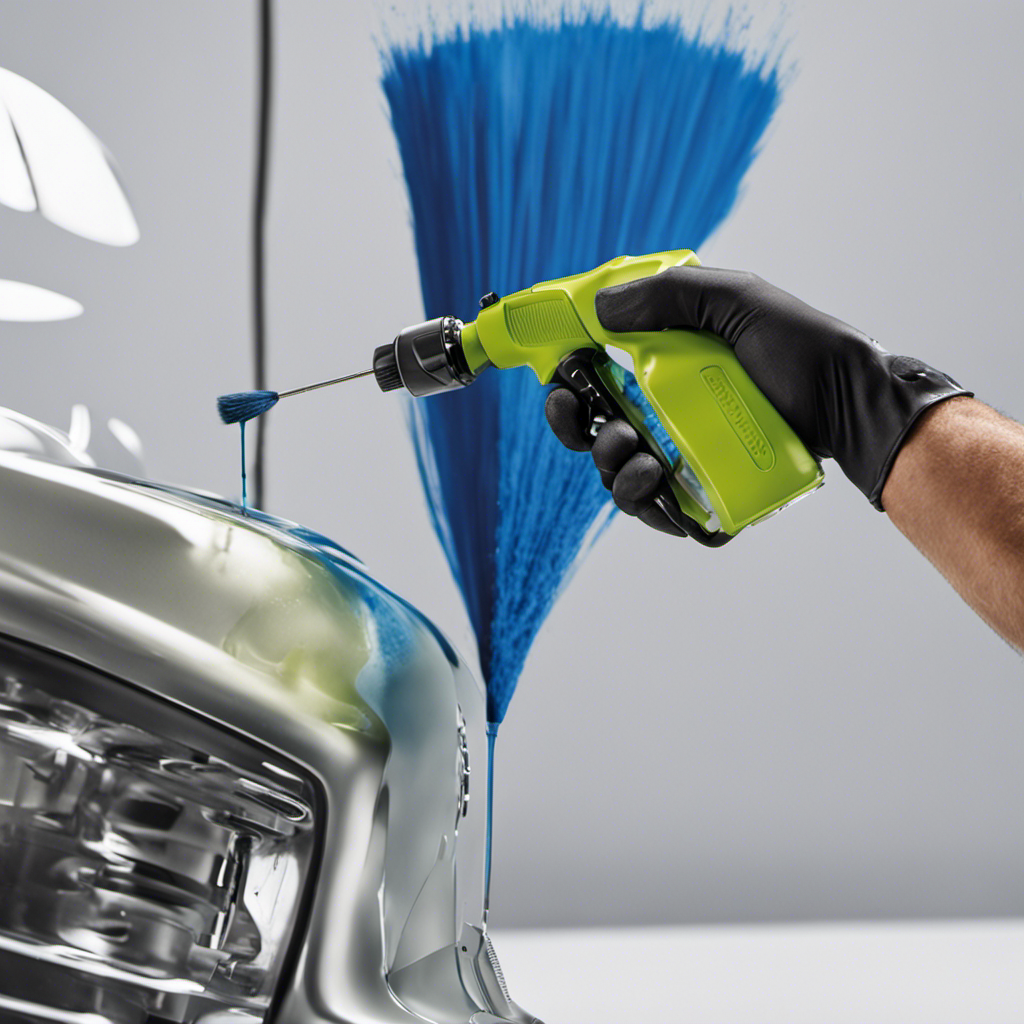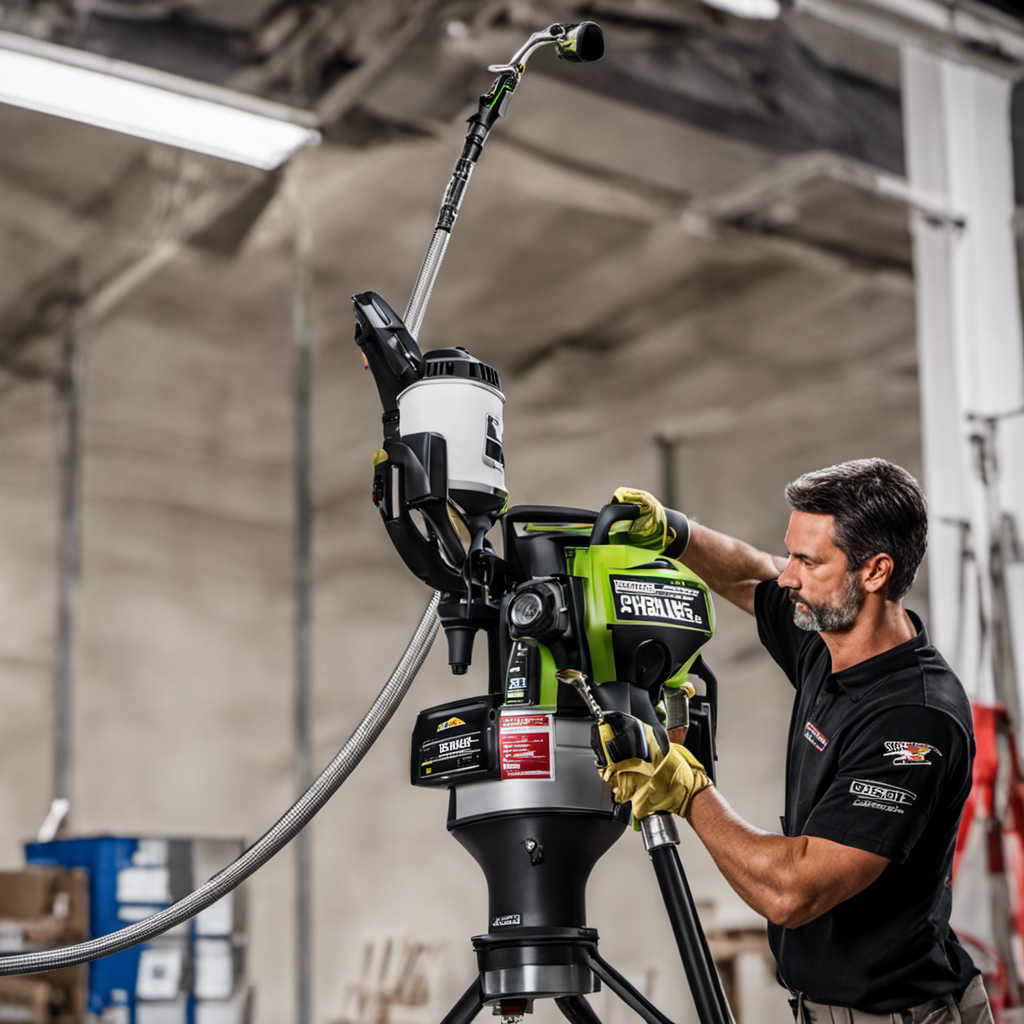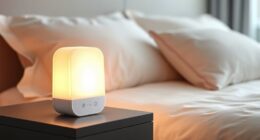Mastering the Krause & Becker Airless Paint Sprayer is crucial in order to achieve results that meet professional standards. By utilizing the right techniques, this powerful tool can significantly reduce the time and effort needed for painting projects.
Did you know that using the correct tip size and adjusting pressure settings can greatly impact the outcome? By familiarizing oneself with the sprayer’s settings and controls, it becomes easier to achieve a smooth and uniform surface.
This article will provide expert tips and guidance to help you unlock the full potential of the Krause & Becker Airless Paint Sprayer.
Key Takeaways
- Using the correct tip size and adjusting pressure settings is crucial for successful spraying with the Krause & Becker Airless Paint Sprayer.
- Understanding and adjusting the spray pattern and pressure helps achieve a smooth and uniform surface.
- Proper surface preparation, including thorough cleaning, repairing cracks, and applying a high-quality primer, is essential for a professional finish.
- Choosing high-quality paint and materials, thinning and straining the paint, and maintaining consistent distance and strokes are important for optimal results.
Using the Correct Tip Size
The user should ensure they are using the correct tip size for the type of paint they are using with the Krause and Becker airless paint sprayer.
Choosing the right nozzle size is crucial for achieving optimal results and avoiding clogs and blockages.
Different paints require different tip sizes for proper atomization and coverage.
Using a tip that is too small can result in clogs and uneven spray patterns, while using a tip that is too large can lead to excessive overspray and wasted paint.
It is recommended to consult the paint manufacturer’s guidelines or the sprayer’s user manual to determine the appropriate tip size for the specific paint being used.
Adjusting Pressure Settings
To achieve optimal results, users should adjust the pressure settings on the sprayer according to the type of paint being used. Proper pressure adjustment techniques are crucial for achieving a smooth and even finish. Here are some tips for adjusting the pressure settings on a Krause and Becker airless paint sprayer:
- Start with the manufacturer’s recommended pressure range for the specific type of paint being used.
- Test the spray pattern and adjust the pressure accordingly. If the pattern is uneven or splotchy, the pressure may need to be increased or decreased.
- Troubleshoot pressure issues by checking for clogs or blockages in the sprayer nozzle or hose.
- Adjust the pressure gradually, making small increments until the desired spray pattern and coverage are achieved.
- If experiencing difficulty with pressure adjustment, consult the sprayer’s user manual or contact customer support for assistance.
Inspecting and Replacing Parts
Inspecting and replacing worn or damaged parts is essential for ensuring the proper functioning and longevity of the airless paint sprayer. Regular maintenance is crucial to avoid any disruptions during painting projects.
When inspecting parts, it is important to carefully examine each component for signs of wear or damage, such as cracks, leaks, or excessive wear. If any issues are found, it is necessary to promptly find suitable replacements for the damaged parts.
This can be done by contacting the manufacturer or authorized dealers to ensure that the replacements are compatible with the specific model of the airless paint sprayer. By regularly inspecting parts and finding appropriate replacements, users can ensure that their airless paint sprayer operates efficiently and effectively for years to come.
Understanding Settings and Controls
Understanding the settings and controls on the airless paint sprayer is crucial for achieving optimal results and avoiding any potential issues during the painting process. To ensure success with a Krause and Becker airless paint sprayer, it is important to familiarize oneself with the various settings and controls.
Here are some key points to keep in mind:
-
Understanding nozzle types:
Different nozzle types produce different spray patterns and widths, so it is important to choose the right nozzle for the job. Nozzle sizes also affect the flow rate and coverage, so be sure to select the appropriate size for the type of paint being used. -
Cleaning and storing the sprayer:
Properly cleaning the sprayer after each use helps prevent clogs and ensures the longevity of the equipment. Storing the sprayer in a clean and dry area protects it from damage and extends its lifespan.
Adjusting Spray Pattern and Pressure
Adjusting the spray pattern and pressure on the Krause and Becker airless paint sprayer is essential for achieving the desired coverage and a professional-looking finish.
To achieve a consistent spray pattern, it is important to hold the sprayer at a 90-degree angle to the surface and maintain a consistent distance. Start and stop spraying away from the surface to avoid uneven application. Overlapping each pass by 50% ensures even coverage.
Techniques for adjusting spray pressure and fan width can also enhance the results. By adjusting the pressure settings on the sprayer, you can control the flow of paint and achieve the desired thickness. To change from a wide fan to a narrow stream, simply adjust the nozzle accordingly.
Changing Fan Width and Stream
To achieve different spray patterns, the user can simply adjust the nozzle on the Krause and Becker airless paint sprayer. Changing the nozzle size allows for a wider fan width or a narrower stream, depending on the desired effect. This feature provides flexibility and control when painting various surfaces.
However, it is important to note that different nozzle sizes may require adjustments to the sprayer’s pressure settings to ensure proper paint flow and coverage.
When troubleshooting spray pattern issues, such as uneven coverage or overspray, changing the nozzle size can be a useful solution. By experimenting with different nozzle sizes, the user can find the optimal setting to achieve the desired spray pattern.
It is also important to check for clogs or debris in the nozzle, as these can affect the spray pattern and result in inconsistent coverage. Regular maintenance and cleaning of the nozzle will help prevent these issues and ensure smooth and precise painting results.
Proper Maintenance and Cleaning
Regularly cleaning and maintaining the sprayer is essential for optimal performance and longevity. To ensure the Krause and Becker airless paint sprayer continues to function at its best, there are a few maintenance tips and cleaning techniques to keep in mind.
First, always clean the sprayer thoroughly after each use. This includes flushing out any leftover paint and debris from the system. Use warm, soapy water and a brush to scrub the sprayer’s components, making sure to remove any clogs or buildup.
Additionally, regularly inspect and replace any worn or damaged parts to prevent any issues during operation.
Troubleshooting Common Issues
The user can troubleshoot common issues with the Krause and Becker airless paint sprayer by following the provided troubleshooting guide.
To troubleshoot paint clogs, they can try the following:
- Check the paint viscosity: Ensure that the paint is thinned to the recommended consistency. If it’s too thick, it can cause clogs in the sprayer.
- Clean the filters: Inspect and clean the filters regularly to remove any debris or paint buildup that may be causing clogs.
To troubleshoot an uneven spray pattern, they can follow these steps:
- Adjust the spray tip: Ensure that the spray tip is properly aligned and securely attached. If it’s loose or damaged, it can cause an uneven spray pattern.
- Check the pressure settings: Adjust the pressure settings on the sprayer to achieve a consistent spray pattern. Too high or too low pressure can result in an uneven application.
Ensuring Longevity of the Sprayer
After troubleshooting common issues with the Krause and Becker airless paint sprayer, it’s important to focus on ensuring the longevity of the sprayer. By following a few key tips, you can maximize its durability and extend its lifespan.
Firstly, it’s essential to properly maintain and clean the sprayer after each use. This includes flushing the system with clean water or solvent, removing any leftover paint or debris, and inspecting the parts for any signs of wear or damage. Regularly replacing worn or damaged parts is crucial for optimal performance.
Secondly, storing the sprayer in a clean and dry environment is essential. Protecting it from extreme temperatures, moisture, and dust will help prevent any potential damage.
Lastly, it’s important to follow the manufacturer’s recommendations and guidelines for operating the sprayer. This includes using the recommended paint and materials, adjusting pressure settings correctly, and using the appropriate tip size for the type of paint being used.
Thorough Surface Preparation
To achieve a smooth and uniform surface, it is crucial to thoroughly clean the surface before painting when using a Krause and Becker airless paint sprayer. Thorough surface preparation is key to achieving a longer-lasting finish. Here are some tips for thorough surface preparation:
-
Clean the surface: Remove any dirt, dust, or debris using a mild detergent or a suitable cleaner. Ensure that the surface is completely dry before proceeding.
-
Repair any imperfections: Fill in any cracks or holes with a suitable filler. Sand the surface to create a smooth and even finish.
-
Apply a primer: Use a high-quality primer to provide a solid base for the paint. This will promote better adhesion and durability.
-
Create a smooth and uniform surface: Sand the primed surface lightly to remove any imperfections and create a smooth finish.
-
Achieve a longer-lasting finish: By properly preparing the surface, you can ensure that the paint adheres well and lasts longer, resulting in a more professional-looking finish.
Repairing Cracks and Imperfections
Repairing cracks and imperfections requires filling them in with a suitable filler and sanding the surface to achieve a smooth and even finish. When it comes to repair techniques, filling gaps is an essential step in achieving a flawless paint job.
To begin, choose a filler that is specifically designed for the type of surface being repaired. This could be a spackling compound for drywall or a wood filler for wooden surfaces. Apply the filler generously to the crack or imperfection, ensuring that it is completely filled.
Once the filler has dried, use a sanding block or sandpaper to carefully sand down the area until it is level with the surrounding surface. This will create a seamless finish and provide a solid foundation for the paint to adhere to.
Applying a High-Quality Primer
When it comes to achieving a flawless finish with the Krause & Becker airless paint sprayer, applying a high-quality primer is crucial. Choosing the right primer is the first step towards a successful paint job. Here are some tips for achieving a flawless finish:
- Choose a primer specifically formulated for the type of surface you are painting.
- Look for a primer that provides good adhesion and covers imperfections.
- Consider using a primer with stain-blocking properties for surfaces prone to discoloration.
Tips for achieving a flawless finish with primer:
- Clean the surface thoroughly before applying the primer to ensure proper adhesion.
- Apply the primer evenly and with consistent coverage to create a smooth base.
- Allow the primer to dry completely before applying the paint.
- Sand the primed surface lightly to remove any imperfections or rough spots.
Creating a Smooth and Uniform Surface
Creating a smooth and uniform surface is essential for achieving a professional-looking paint job with the Krause & Becker airless paint sprayer. To achieve a flawless finish, it is crucial to select the right paint type for the surface being painted.
Different surfaces require different types of paint, such as latex, oil-based, or enamel. Latex paint is ideal for interior walls, while oil-based paint is suitable for exterior surfaces or areas prone to high moisture. Enamel paint provides a durable and glossy finish, perfect for furniture or cabinets. By selecting the right paint type, you ensure better adhesion, coverage, and a longer-lasting finish.
Additionally, proper surface preparation is essential for achieving a smooth and uniform surface. This includes cleaning the surface, repairing any imperfections, and applying a high-quality primer. These steps help to create a solid foundation for the paint and ensure better adhesion and durability.
Taking the time to properly prepare the surface and select the right paint type will greatly enhance the overall quality of your paint job. It will result in a smooth and uniform finish that looks professional and lasts longer. So, before you start painting with the Krause & Becker airless paint sprayer, make sure to follow these important steps for a successful paint job.
Using High-Quality Paint and Materials
Using high-quality paint and materials is key to achieving a professional and long-lasting finish with the Krause & Becker airless paint sprayer. When using this sprayer, it is important to choose the right paint consistency and maintain a consistent distance from the surface.
Here are some tips for using high-quality paint and materials with the Krause & Becker airless paint sprayer:
-
Choose paints that are specifically formulated for airless spraying. These paints are designed to work seamlessly with the sprayer, ensuring optimal results.
-
Thin the paint to the recommended consistency to ensure smooth and even application. This will prevent clogs and ensure proper atomization of the paint.
-
Strain the paint before pouring it into the sprayer to remove any impurities or particles that could affect the finish.
-
Maintain a consistent distance from the surface while spraying. This will help achieve an even coat and prevent overspray or uneven coverage.
-
Use smooth and overlapping strokes to ensure complete coverage and a seamless finish. This technique will also help avoid streaks or lines in the final result.
Mastering Proper Spraying Technique
To achieve optimal results with the Krause & Becker airless paint sprayer, one must maintain a consistent spray pattern and adjust spray pressure and fan width as needed.
Achieving consistent coverage requires holding the sprayer at a proper spray angle of 90 degrees to the surface. This ensures that the paint is evenly distributed and avoids streaks or uneven patches. Additionally, starting and stopping the spraying motion away from the surface helps to prevent over-application or drips.
To achieve a smooth and uniform finish, it is important to overlap each pass by 50%. By adjusting the spray pressure and fan width, one can customize the application to suit the specific project requirements.
Following these techniques will result in professional-looking results and a job well done.
Frequently Asked Questions
Can I Use the Krause & Becker Airless Paint Sprayer for Other Types of Projects Besides Painting Walls?
Yes, the Krause & Becker Airless Paint Sprayer can be used for a variety of projects beyond just painting walls. It is a versatile tool that can be used for furniture refinishing, allowing for a smooth and professional finish.
Additionally, the sprayer can be used for creative projects, such as applying stains or sealants to outdoor decks or fences. Its efficient and even application makes it a valuable tool for any project requiring a smooth and professional finish.
What Safety Precautions Should I Take When Using the Krause & Becker Airless Paint Sprayer?
When using the Krause & Becker Airless Paint Sprayer, it’s important to take certain safety precautions. This includes wearing appropriate protective gear such as goggles, gloves, and a respirator to protect against paint fumes and overspray.
It’s also essential to ensure proper ventilation in the work area. Additionally, it’s crucial to thoroughly clean the sprayer after each use to prevent clogging and maintain its performance.
These safety measures will help ensure a safe and successful painting experience.
How Do I Properly Store the Krause & Becker Airless Paint Sprayer When Not in Use?
Proper storage techniques are important for maintaining the Krause & Becker Airless Paint Sprayer when not in use. To ensure its longevity, it should be stored in a clean and dry area, away from extreme temperatures and direct sunlight.
It is recommended to relieve any pressure in the system before storing and to clean the sprayer thoroughly, removing any paint residue.
Additionally, regular maintenance tips include inspecting and replacing worn or damaged parts and keeping the sprayer clean and free from debris.
Can I Use the Sprayer With Different Types of Paint, Such as Oil-Based or Water-Based?
Yes, the Krause & Becker Airless Paint Sprayer can be used with different types of paint, including oil-based and water-based paints. It is important to understand the cleaning process for each type of paint to ensure proper functionality and longevity of the sprayer.
When using latex or enamel paints, it is recommended to thoroughly clean the sprayer after each use to prevent clogging and maintain optimal performance. Following the manufacturer’s instructions and using appropriate cleaning agents will help maintain the sprayer’s efficiency.
How Do I Know if the Krause & Becker Airless Paint Sprayer Is Compatible With the Paint I Want to Use?
Determining paint compatibility with the Krause & Becker Airless Paint Sprayer is crucial for achieving optimal results. To ensure compatibility, consult the paint manufacturer’s guidelines or labels. These will indicate whether the paint is suitable for airless spraying.
Additionally, the sprayer’s instruction manual may provide recommendations for compatible paint types. If any issues arise during the spraying process, such as clogs or uneven application, refer to the troubleshooting section of the manual for solutions.
Conclusion
In conclusion, if you want to achieve absolute perfection with the Krause & Becker Airless Paint Sprayer, just throw it out the window and hire a professional painter. Because who needs hassle-free, efficient, and cost-effective painting when you can spend hours dripping, splattering, and giving your walls a unique abstract touch?
But if you’re still determined to master this devilish contraption, follow the tips and guidelines provided. Good luck, brave souls! May your walls be ever so slightly less disastrous.
Franz came aboard the Paint Sprayer Zone team with a background in both journalism and home renovation. His articulate writing style, combined with a passion for DIY projects, makes him an invaluable asset. Franz has a knack for breaking down technical jargon into easy-to-understand content, ensuring that even the most novice of readers can grasp the complexities of paint sprayers.
